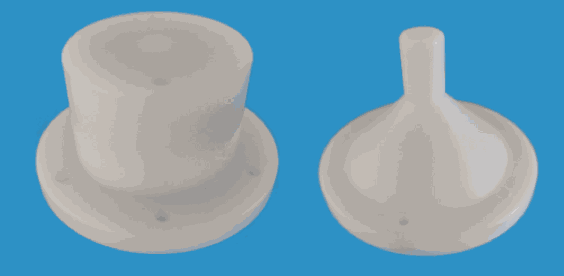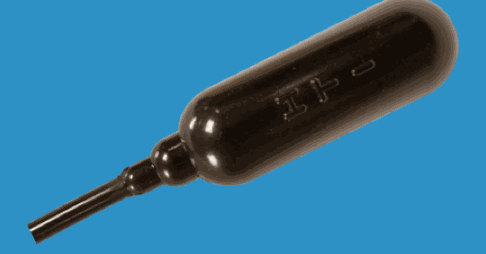Record. Localize. Endure.
SonarPoint™ currently offers two hydrophone options (if that isn't adequate for your circumstances, please contact us) which offer recording from 2Hz - 250kHz with either an end-cap integrated or free-field configuration.
SH33/SH125 - Endcap Integration

This hydrophone option is screwed into one end of the SonarPoint recorder, which mean the durability of this option is highest since the chance of a snag or something hittig the hydrophone is low. The left model is the SH33 with recording from 2Hz - 33kHz. The right model is the SH125 with recording from 2Hz - 125kHz. Please note, this comfiguration offers great durability and a cost-efective approach, however, it is not recomended for missions which require extremely qiuet recordings. Due to the hollow, air-filled chamber of the SonarPoint recorder, this hydrophone configuration will result in minor sound reverberations.
| Model | Sensativity | Frequency Response | Form | Price (USD) |
| SH33 | Full scale 130 - 240 db selectable Noise 100 - 120 db below FS | 2Hz - 33kHz | End-cap Integrated | 700 |
| SH125 | Full scale 130 - 240 db selectable Noise 100 - 120 db below FS | 2Hz- 125kHz | End-cap Integrated | 700 |

The HTI-99-UHF offers freuency response of 2Hz - 250kHz . This option offers the best performance with a potential for snags or getting caught due to the wired nature. The hydrophone sits several meters away from the recorder and is attached via a cable. There is no presence of sound reverberations.
| Model | Sensativity | Frequency Response | Form | Price (USD) |
| HTI-99-UHF |
Full scale 155 db re. uq Pa Noise 15 db re. 1uq Pa / √Hz
|
2Hz - 250kHz | Free-Field | 3,000 |
Sound source localization arrays work by a phenomenon known as a differential time of arrival (DTOA). As a sound source propagates through the horizontal water column, it will reach each recording location at a different time (3 or more are required). Using the difference in when the sound reached each recording location, you can determine, with sub-meter (in ideal conditions) accuracy, where a sound source originated from and potential it's directional heading and speed. To ensure the time measurement among all recording stations is in-sync (to provide the best accuracy and avoid errors), SonarPoint uses several time synchronization techniques listed below. Please note, each of these techniques is optional and will be recommended depending on your unique mission/project circumstances and goals, please inquire if you have questions. Ask a question.
Internal GPS module each SonarPoint™ recorders comes with an internal GPS module, which, upon the recorder being turned on, will connect and sync to exact GPS time (atomic clock). This method of initial time synchronization ensures each recorder is time synchronized to each other before deployment begins.
Repeater Buoy A repeater buoy offers surface expression and also has an internal GPS module. A SonarPoint™ recorder will be linked to it and subsequently periodically receive the GPS 1PPS signal (exact time) from the repeater buoy. This configuration would, therefore, require that each station (recorder) has its repeater buoy. This setup is typically recommended as the "Drifting Array," which is best used in rapid deployment situations for the short-term. Additionally, the repeater buoy will make physical tracking of the system easy via transmissions to the Argos satellite constellation or GPS location (customer may choose).
Synchronization Pinger This module is often used for fixed arrays for medium to long-term deployments and propagates a time signal to each recorder. In post analysis, the "master time signal" is then used to sync all recording segments for the best accuracy. Often a mission/project only calls for one pinger; although greater distance or high accuracy applications may require more than one unit, please contact us more recommendations/advice.
Master Clock System In the case of a tight array, it is possible to time synchronize each recorder through one master system. In this configuration, the "master" is the reference of time for each "slave." This avoids the need/use of a synchronization pinger. However, it does require a daisy-chained setup and fairly close recorder placement. Even with close recorder placement (centimeters), highly accurate localization may still be achieved for most any mission/project.
| Model | Memory | Max Depth |
Endurance 1 @100 ks/s (days):
wireless / wired sync |
Endurance 1 @312.5 ks/s (days):
wireless / wired sync |
Endurance
2
@416.7 ks/s (days):
wireless / wired sync |
| SPxxx-2 | Up to 2TB | 300 meter |
20 / 9 days
|
12 / 7 days | 6 / 4 days |
| SPxxx-8 | Up to 8TB | 300 - 1800 meter versions |
89 / 41 days |
52 / 31 days | 25 / 19 days |
| SPxxx-8 + SPB-175AH battery pack | Up to 8TB | 300 - 1800 meter versions |
433 / 201 days
|
159 / 152 days (Memory limited for wireless. Requires 1TB cards) | 119 / 92 days (Memory limited for wireless. Wireless requires 1TB cards) |
1 With Lexar Pro 512GB memory cards: Lower power but slower, suitable for use up to 312.5 ks/s. Continous recording (100% duty cycle). 2 With SanDisk Extreme PRO 512GB cards: Faster but higher power, required for > 312.5 ks/s. Continuous recording (100% duty cycle).
Important: Endurance numbers are from a combination of field endurance recording tests, lab measurements and interpolations between measurements. All tests done with 512GB cards, and assuming same power consumption for 1TB cards of the same brand and product line. All numbers are without a safety margin. Please allow for a suitable safety margin and conduct tests prior to deployment. Please contact Desert Star for a detailed spreadsheet with more resuts and sources, or advise on endurance testing and safety margins for your application. Last updated: 15JUL2022.
GPS Models with Localizing Capabilties
SP300-2
Standard Duration
$ 3,500
Or $2,500 without GPS
- 300m Depth Rated
- 2TB Max Memory, 2 SD Cards
- SPIB-10.4AH Internal Battery Included
- Best for Drifter Arrays
SP300-8
Long Duration
$ 6,000
Or $5,000 without GPS
- 300m Depth Rated
- 8TB Max Memory, 8 SD Cards
- SPIB-45AH Internal Battery Included
- Best for fixed arrays
SP1000-8
Extended Depth
$7,000
Or $6,000 without GPS
- 1000m Depth Rated
- 8TB Max Memory, 8 SD Cards
- SPIB-45AH Internal Battery Included
Deep Sea Studies
Software
Long-term recording segments or mission/project durations incur massive amounts of data (up to 8000 GB per recorder) and therefore require specialized data extraction, processing, and analysis tools. In order to avoid time bottlenecks, SonarPoint™ utilizes software with a batch process emphasis. Using command-line tools, batch processing is possible and actually quite easy if instructions are properly followed.
Processing Chain
| Function | Name | Input | Output |
| Recorder Configuration | SP-DOCK | Configuration Parameters | Recorder ready to deploy |
| File Recovery | SP-READ | Raw data from SD cards | Single-channel .WAV |
| File Merge & Sync | SP-MERGE | Single-channel .WAV files | Time sync multi-channel .WAV |
| Event Detection and Timing | SP-DETECT | Multi-channel .WAV files | .csv with event times and hydrophone positions |
| Event Localization | SP-LOCALIZE | .csv with event times and hydrophone positions | .csv with event location and vector |
